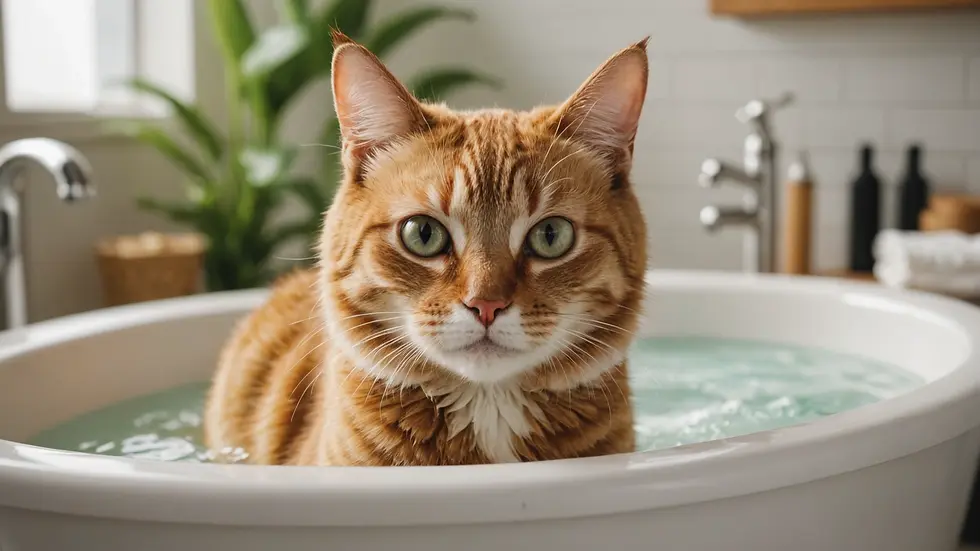7 Surprising Ways to Minimize Shedding in Cats: A Fresh Approach
- Jyotiraj Borah
- Feb 6
- 4 min read
Cats are cherished companions, but shedding can be a frustrating challenge for many pet owners. The amount of fur left behind can be surprising, leading to a constant battle against the hair on your clothes, furniture, and floors. While shedding is a normal part of a cat’s life, there are effective strategies to help keep your home tidier.
In this post, we'll explore seven surprising ways to minimize shedding in cats. With a better understanding of your feline's grooming needs and lifestyle, you can create a fur-free environment while keeping your cat healthy and happy.
Understanding Shedding in Cats
Before we jump into solutions, it is essential to grasp the reasons behind shedding. Shedding is a natural process that enables cats to discard old or damaged fur for new growth. Factors influencing shedding include breed, age, season, and diet. For instance, indoor cats typically shed more during winter months when they might be exposed to artificial heating.
Cats can lose a surprising amount of hair, averaging about 50 to 100 strands a day! This is especially true during seasonal changes in spring and fall when they prepare for temperature shifts. Knowing these patterns helps you implement targeted solutions to limit shedding.
1. Invest in a Quality Grooming Tool
A great way to manage shedding is by using a quality grooming tool tailored for your cat’s coat type. For example, slicker brushes work exceptionally well for long-haired breeds like Persians, while rubber grooming gloves can effectively catch loose hairs from short-haired cats like Siamese.
By grooming your cat regularly, you can reduce the amount of loose hair left on your furniture and floors. A consistent grooming routine not only minimizes shedding but also strengthens the bond between you and your furry friend.

2. Maintain a Healthy Diet
Your cat’s diet greatly affects their health, including their coat condition. High-quality cat food enriched with omega-3 and omega-6 fatty acids promotes a healthier coat and can lead to reduced shedding. Brands like Royal Canin and Hill’s Science Diet offer formulas tailored to specific dietary needs.
Discuss your cat’s dietary needs with your veterinarian, as a balanced diet is crucial. Research indicates that up to 30% of shedding can be alleviated by improving dietary quality. A healthier cat is less likely to experience excessive hair loss.
3. Regular Baths
While cats are generally good at grooming themselves, occasional baths can help manage shedding. Most cats can tolerate bathing if it is introduced gradually. Aim for a gentle approach and use a cat-specific shampoo to avoid skin irritation.
Regular baths help remove loose fur, dirt, and dander, which also reduces allergens around your home. Just be sure to dry your cat thoroughly after bathing to keep them comfortable.

4. Create a Comfortable Environment
A stress-free environment is essential for your cat's well-being. Stress can cause increased shedding, so it is vital to provide a safe space for your feline friend. Offer comfortable beds, scratching posts, and cozy hiding spots where they can retreat when feeling anxious.
Additionally, interactive toys can keep your cat engaged and mentally stimulated. A sense of security can reduce stress-related shedding, leading to a happier and healthier pet.
5. Maintain Regular Vet Check-Ups
Regular veterinary check-ups are critical for your cat's health and can help identify issues that lead to excessive shedding. Conditions like skin allergies, parasites, or hormonal imbalances can increase fur loss.
Routine visits allow for early detection and treatment of these concerns. Keeping your cat up to date on vaccinations and health screenings is vital for maintaining their overall health, which, in turn, can mitigate shedding issues.
6. Hydration Matters
Hydration is crucial for skin health and can directly affect shedding. Cats often prefer fresh water, so ensure they have access to clean water daily. A pet water fountain can encourage drinking, as many cats are attracted to moving water.
In addition, incorporating wet cat food into their diet can provide extra moisture. Keeping your cat well-hydrated can reduce shedding significantly, leading to improved coat condition.
7. Consider Cat-Safe Supplements
If you have tried different strategies and continue to face shedding challenges, cat-safe supplements might be beneficial. Products containing fatty acids and vitamins can enhance skin health and coat quality, helping to reduce shedding.
Before introducing any supplement, it is essential to consult your veterinarian. They can recommend effective products tailored to your cat's needs and health conditions.
Achieving a Fur-Free Home
Managing shedding in cats may involve several techniques, but the key is to be proactive. By investing in grooming tools, maintaining a healthy diet, and creating a cozy environment, you can greatly reduce the amount of fur in your home.
Shedding is a natural process, but you can take meaningful steps to manage it effectively. Embrace these insights and enjoy the companionship of your cat—while keeping your living space clean and tidy. With a bit of effort and patience, you can achieve a better balance between enjoying your cat and managing their shedding. Happy fur-reduction!




Comments